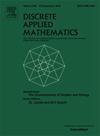On the smallest positive eigenvalue of caterpillar unicyclic graphs
IF 1
3区 数学
Q3 MATHEMATICS, APPLIED
引用次数: 0
Abstract
Let be a simple graph with the adjacency matrix . By the smallest positive eigenvalue of , we mean the smallest positive eigenvalue of and denote it by . For , let be the cycle graph with vertices and be nonnegative integers. A caterpillar unicyclic graph is a graph obtained from by adding pendant vertices to the vertex of , for . Let be the class of all caterpillar unicyclic graphs on vertices, where each is positive. In this article, we obtain the graphs with the maximum among all the graphs in . Furthermore, we characterize the graphs in such that and , respectively. As a consequence, we obtain the graphs with the minimum among all the graphs in . Let be the set of all smallest positive eigenvalues of the caterpillar unicyclic graphs in . We show that the largest limit point of is not finite and the smallest limit point of is .
关于履带单环图的最小正特征值
设G为邻接矩阵a (G)的简单图。G的最小正特征值是指A(G)的最小正特征值,用τ(G)表示。当k≥3时,设Ck为顶点为1,2,…,k的循环图,且n1,n2,…,nk为k个非负整数。履带单环图Ck(n1,n2,…,nk)是在Ck的顶点i上加上ni个垂顶点得到的图,其中i=1,2,…,k。设Cn是有n个顶点的所有履带单环图的类,其中每个ni都是正的。在本文中,我们得到了Cn中所有图中τ最大的图。进一步,我们刻画了Cn中的图G,分别使τ(G)=2−1和τ(G)>2−1。因此,我们得到了Cn中所有图中τ最小的图。设Υ为Cn中履带式单环图的所有最小正特征值的集合。我们证明了Υ的最大极限点不是有限的,Υ的最小极限点是2−1。
本文章由计算机程序翻译,如有差异,请以英文原文为准。
求助全文
约1分钟内获得全文
求助全文
来源期刊

Discrete Applied Mathematics
数学-应用数学
CiteScore
2.30
自引率
9.10%
发文量
422
审稿时长
4.5 months
期刊介绍:
The aim of Discrete Applied Mathematics is to bring together research papers in different areas of algorithmic and applicable discrete mathematics as well as applications of combinatorial mathematics to informatics and various areas of science and technology. Contributions presented to the journal can be research papers, short notes, surveys, and possibly research problems. The "Communications" section will be devoted to the fastest possible publication of recent research results that are checked and recommended for publication by a member of the Editorial Board. The journal will also publish a limited number of book announcements as well as proceedings of conferences. These proceedings will be fully refereed and adhere to the normal standards of the journal.
Potential authors are advised to view the journal and the open calls-for-papers of special issues before submitting their manuscripts. Only high-quality, original work that is within the scope of the journal or the targeted special issue will be considered.
 求助内容:
求助内容: 应助结果提醒方式:
应助结果提醒方式:


